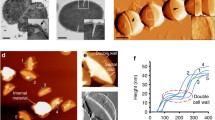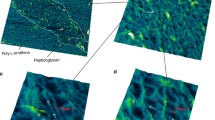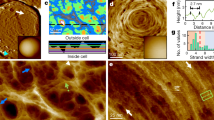Abstract
Atomic force microscopy (AFM) has been used extensively to characterize the surface structure and mechanical properties of bacterial cells. Extraction of the cell wall peptidoglycan sacculus enables AFM analysis exclusively of peptidoglycan architecture and mechanical properties, unobscured by other cell wall components. This has led to discoveries of new architectural features within the cell wall, and new insights into the level of long range order in peptidoglycan (Turner et al. Mol Microbiol 91:862–874, 2014). Such information has great relevance to the development of models of bacterial growth and division, where peptidoglycan structure is frequently invoked as a means of guiding the activities of the proteins that execute these processes.
Access provided by CONRICYT – Journals CONACYT. Download protocol PDF
Similar content being viewed by others
Key words
1 Introduction
AFM is a scanning probe microscopy technique in which a sharp tip with a point diameter of about 10 nm is moved back and forth over a sample, building up an image from the height profile of each sequentially scanned line. AFM is not diffraction limited and therefore yields very high resolution. Combined with an intrinsically good signal-to-noise ratio, AFM is an excellent technique for analysis of disordered surfaces on length scales from a few nanometres to a few micrometres. The capability to measure force additionally enables nanoscale mapping of mechanical properties. AFM has been applied to analyze both the cell walls of living bacteria and extracted peptidoglycan sacculi which are either left intact or broken open to reveal the inner surface [1, 2]. Here, we restrict ourselves to the techniques required for imaging of sacculi.
Sacculus imaging has now been successfully applied to Escherichia coli, Pseudomonas aeruginosa, Campylobacter jejuni, Caulobacter crescentus, Bacillus subtilis, Staphylococcus aureus, Lactococcus lactis, Streptococcus pneumoniae, and Enterococcus faecalis [3–7]. This protocol should therefore work for these and similar species. The protocol varies mainly between Gram-positive and Gram-negative species, but there are some species-specific variations. For a peptidoglycan sacculus purification protocol applicable to a very broad range of species, but which has not been tested by AFM, see [8].
The sample preparation has two phases. The first is extraction of sacculi from the organism of interest and the second is mounting the sample for AFM imaging. The AFM imaging should be carried out in an intermittent contact mode (e.g., tapping mode) in ambient conditions. Operation of the AFM itself is beyond the scope of this protocol and should be carried out in accordance with the instrument manual.
2 Materials
Follow all local safety and waste disposal procedures when following this protocol. Purification of Gram-positive peptidoglycan involves the use of hydrofluoric acid which can be particularly hazardous. It has been assumed that normal microbiology lab equipment is available to the reader, but more specialised items have been listed here.
2.1 Purification of Peptidoglycan Sacculi
-
1.
Distilled water.
-
2.
HPLC-grade water.
-
3.
Phosphate-buffered saline (PBS): Make from tablets (Gibco 18912-0140) following the manufacturer’s instructions. Autoclave.
-
4.
Sodium dodecyl sulfate (SDS) solution (5 % w/v): Add 100 mL distilled water to 5 g SDS in a suitable container and mix. Store at room temperature.
2.1.1 Purification of Peptidoglycan Sacculi from Gram-Positive Bacteria
-
1.
For breaking B. subtilis: French Press.
-
2.
For breaking S. aureus: FastPrep (MP Biomedicals FastPrep-24), FastPrep tubes (MP Biomedicals Lysing Matrix B 6911-100).
-
3.
Tris buffer (50 mM, pH 7): Add 3 g Tris base to 500 mL distilled water. Adjust to pH 7 using 1 M hydrochloric acid. Autoclave.
-
4.
Pronase stock solution (20 mg/mL):
-
(a)
Make a Tris buffer (1 M, pH 7.5): Add 60.6 g Tris base to 500 mL distilled water. Adjust to pH 7.5 using 1 M hydrochloric acid.
-
(b)
Make a sodium chloride solution (4 M): Add 116.9 g sodium chloride to 500 mL distilled water.
-
(c)
Combine 50 mL distilled water, 0.5 mL Tris buffer (1 M, pH 7.5), 0.125 mL sodium chloride solution (4 M) and 1 g protease (Sigma P6911).
-
(d)
Incubate the solution for 1 h at 37 °C.
-
(e)
Filter sterilize the solution using a 0.22 μm filter.
-
(f)
Split into 1 mL aliquots and store at −20 °C until required.
-
(a)
-
5.
Hydrofluoric acid (48 % v/v).
-
6.
pH indicator strips.
2.1.2 Purification of Peptidoglycan Sacculi from Gram-Negative Bacteria
-
1.
SDS solution (10 % w/v): Add 100 mL distilled water to 10 g SDS in a suitable container and mix. Store at room temperature.
-
2.
Sodium phosphate buffer (50 mM, pH 7.3):
-
(a)
Add 1.2 g sodium dihydrogen phosphate to 200 mL distilled water and mix.
-
(b)
Add 1.4 g disodium hydrogen phosphate to 200 mL distilled water and mix.
-
(c)
While mixing, gradually add sodium dihydrogen phosphate solution to disodium hydrogen phosphate solution until the pH is 7.3.
-
(d)
Autoclave.
-
(a)
-
3.
Ultracentrifuge capable of reaching 400,000 × g.
-
4.
Ultracentrifuge tubes.
-
5.
α-Chymotrypsin stock solution (1 mg/mL): Suspend 10 mg α-chymotrypsin in 10 mL in sodium phosphate buffer (50 mM, pH 7). Store 1 mL aliquots at −20 °C until required.
-
6.
Tip sonicator (if broken sacculi are required) (MSE Soniprep 150 with 3 mm diameter probe).
2.2 Mounting of Peptidoglycan Sacculi for AFM Imaging
-
1.
Steel pucks.
-
2.
Mica discs.
-
3.
Epoxy glue.
-
4.
Tip sonicator (Gram-positive bacteria) (MSE Soniprep 150 with 3 mm diameter probe).
-
5.
Scotch tape.
3 Methods
3.1 Purification of Peptidoglycan Sacculi from Gram-Positive Bacteria
-
1.
Grow one liter of liquid bacterial culture to an OD600 of approximately 0.5.
-
2.
Chill on ice.
-
3.
Centrifuge at 15,950 × g for 10 min.
-
4.
Resuspend in 1 mL PBS. This will result in more than 1 mL of bacterial suspension.
-
5.
Split the suspension equally between four 1.5 mL Eppendorf tubes.
-
6.
Boil in a water bath for 10 min (kills bacteria).
-
7.
Allow bacterial suspension to cool to room temperature.
-
8.
Follow “Breaking S. aureus” or “Breaking B. subtilis” sub-protocols, if desired.
-
9.
Centrifuge for 3 min at 20,000 × g and discard supernatant.
-
10.
Resuspend pellets in 1 mL 5 % (w/v) SDS (see Note 1 ).
-
11.
Boil for 25 min.
-
12.
Centrifuge for 3 min at 20,000 × g and discard supernatant.
-
13.
Resuspend pellets in 1 mL 5 % (w/v) SDS.
-
14.
Boil for 15 min (see Note 2 ).
-
15.
Centrifuge for 3 min at 20,000 × g and discard supernatant. Repeat this five times, resuspending the pellet in distilled water each time.
-
16.
Resuspend pellets in 0.9 mL Tris–HCl (50 mM, pH 7) and add 0.1 mL pronase stock solution. Incubate the sample at 60 °C for 90 min.
-
17.
Centrifuge for 3 min at 20,000 × g and discard supernatant. Resuspend in distilled water, then centrifuge again using the same conditions, and discard supernatant.
-
18.
Carefully observing local safety and waste disposal procedures, resuspend the pellets in 250 μL hydrofluoric acid (HF).
-
19.
Incubate for 48 h at 4 °C. This removes teichoic acids.
-
20.
Centrifuge for 3 min at 20,000 × g and safely discard supernatant. Repeat this, resuspending the pellet in distilled water each time, until the pH of the supernatant is 5 as measured using an indicator strip.
-
21.
Resuspend in a minimal quantity of HPLC-grade water (about 100 μL).
-
22.
Store at −20 °C until further use.
3.2 Purification of Peptidoglycan Sacculi from Gram-Negative Bacteria
-
1.
Grow 1 L of liquid bacterial culture to an OD600 of approximately 0.5.
-
2.
Chill on ice.
-
3.
Centrifuge at 15,950 × g for 10 min.
-
4.
Resuspend in 1 mL PBS (or distilled water for C. crescentus). This will result in more than 1 mL of bacterial suspension.
-
5.
Follow “Breaking Gram-negative bacteria” sub-protocol, if desired.
-
6.
Heat 3 mL 5 % (w/v) SDS to 100 °C in a 50 mL Falcon tube using a dry heat block.
-
7.
Add bacterial suspension to this dropwise.
-
8.
Leave to boil for 30 min.
-
9.
Transfer bacterial suspension to an ultracentrifuge tube.
-
10.
Collect pellet by ultracentrifugation at 400,000 × g for 15 min at room temperature.
-
11.
Resuspend pellet in distilled water using a fine-tipped plastic Pasteur pipette (see Note 1 ) and repeat ultracentrifugation four times.
-
12.
Resuspend in 3.6 mL sodium phosphate buffer (50 mM, pH 7.3). Add 0.4 mL α-chymotrypsin stock solution. Incubate overnight at 37 °C, with agitation on an orbital shaker.
-
13.
Mix with 4 mL 10 % (w/v) SDS in a 50 mL Falcon tube.
-
14.
Boil for 30 min using a dry heat block.
-
15.
Collect pellet by ultracentrifugation at 400,000 × g for 15 min at room temperature.
-
16.
Resuspend pellet in distilled water and repeat ultracentrifugation twice.
-
17.
Resuspend in a minimal quantity of HPLC-grade water (about 100 μL).
-
18.
Transfer to Eppendorf tubes.
-
19.
Boil tubes for 10 min in a water bath.
-
20.
Store at 4 °C until further use.
3.3 Breaking S. aureus
Samples should be kept as close to 4 °C as possible throughout these steps.
-
1.
Transfer from 1.5 mL Eppendorfs to FastPrep tubes.
-
2.
FastPrep treat the samples 6× at speed 6 for 30 s with a ~1-min pause between each run. Check for breakage by optical microscopy using a 100× oil immersion objective (see Note 3 ). If the cells have not broken, keep repeating the FastPrep cycles until >95 % breakage is observed by optical microscopy.
-
3.
Spin down for 30 s at 1000 rpm, to separate beads (pellet) from the supernatant (cell extracts).
-
4.
Transfer supernatant to Eppendorfs.
3.4 Breaking B. subtilis
Samples should be kept as close to 4 °C as possible throughout these steps.
-
1.
Pool samples in a 50 mL Falcon tube.
-
2.
Run through French Press at 500 psi.
-
3.
Check for breakage by optical microscopy using a 100× oil immersion objective. If the cells are not broken, keep repeating French Press step until >95 % breakage is observed by optical microscopy.
-
4.
Transfer sample to Eppendorfs.
3.5 Breaking Gram-Negative Bacteria
Samples should be kept as close to 4 °C as possible throughout these steps.
-
1.
Transfer sample to a 20 mL plastic universal tube.
-
2.
Top up to approximately 3 mL with PBS.
-
3.
Dip sonicator probe about 1.5 cm into the sample and switch on the sonicator for 30 s at an amplitude of 5 μm.
-
4.
Check sample by optical microscopy using a 100× oil immersion objective. If the cells are not broken, keep repeating the sonication step until >95 % breakage is observed by optical microscopy.
3.6 Preparation of Steel-Mica Stubs for AFM
-
1.
Use a minimal amount of epoxy to stick mica discs to steel stubs and leave to cure. These can be stored indefinitely.
-
2.
Immediately before use, apply scotch tape sticky side down upon the mica surface and pull away to remove the top layer of mica (see Note 4 ).
3.7 Preparation of Sacculus Suspensions (Gram-Positive)
-
1.
Dilute peptidoglycan stock in HPLC-grade water, e.g., 5 μL peptidoglycan stock to 400 μL HPLC-grade water (see Note 5 ).
-
2.
Use a tip sonicator to disperse the sacculus suspension (e.g., dip the sonicator probe about 0.5 cm into the sample and activate the sonicator for 3 × 30 s bursts at 5 μm amplitude for S. aureus or 1 × 20 s burst at 5 μm amplitude for B. subtilis).
3.8 Preparation of Sacculus Suspensions (Gram-Negative)
-
1.
Dilute peptidoglycan stock in HPLC-grade water, e.g., 1 μL peptidoglycan stock to 50 μL HPLC-grade water (see Note 5 ).
-
2.
Mix briefly with a vortex mixer.
3.9 Mounting of Peptidoglycan Sacculi for AFM Imaging
-
1.
Pipette 2 μL of sacculus suspension onto a freshly cleaved mica stub (see Note 6 ).
-
2.
Direct a gentle flow of nitrogen gas onto the stub until the water has evaporated (see Note 6 ).
-
3.
Using two pipettes, load 50 μL of HPLC-grade water into one leaving the other with an empty tip. Pipette the water onto the mica (see Note 6 ), then aspirate with the empty pipette, and discard the aspirated solution. Repeat this process for a total of three times.
-
4.
Direct a vigorous flow of nitrogen onto the stub to “blow off” the remaining solution (see Note 7 ). Ensure that the sample is completely dry.
4 Notes
-
1.
Resuspending in SDS and washing SDS out results in a lot of foam. Take care that this does not overspill the Eppendorf.
-
2.
The sample can be stored overnight at this point.
-
3.
Take great care not to transfer the glass FastPrep beads onto the microscope slide as this will make it difficult to apply a cover slip. If beads do end up on the slide, use the cover slip to push them out of the way.
-
4.
Ensure that a complete layer has been removed as parts of the surface that had previously been exposed are contaminated. Stubs can be reused until there is no mica left.
-
5.
You may need to try several different dilution factors to find an appropriate working concentration.
-
6.
Do not let the drop overspill the mica as it will wash contaminants from the steel stub into your sample. If the drop does overspill, dry off the mica with a tissue and cleave it again before starting over.
-
7.
At this point try and blow the liquid clean off the mica.
References
Turner RD, Vollmer W, Foster SJ (2014) Different walls for rods and balls: the diversity of peptidoglycan. Mol Microbiol 91:862–874
Dufrêne YF (2014) Atomic force microscopy in microbiology: new structural and functional insights into the microbial cell surface. MBio 5:e01363–14
Turner RD, Hurd AF, Cadby A et al (2013) Cell wall elongation mode in Gram-negative bacteria is determined by peptidoglycan architecture. Nat Commun 4:1496
Yao X, Jericho M, Pink D, Beveridge T (1999) Thickness and elasticity of gram-negative murein sacculi measured by atomic force microscopy. J Bacteriol 181:6865–6875
Hayhurst EJ, Kailas L, Hobbs JK, Foster SJ (2008) Cell wall peptidoglycan architecture in Bacillus subtilis. Proc Natl Acad Sci U S A 105:14603–14608
Wheeler R, Mesnage S, Boneca IG et al (2011) Super-resolution microscopy reveals cell wall dynamics and peptidoglycan architecture in ovococcal bacteria. Mol Microbiol 82:1096–1109
Turner RD, Ratcliffe EC, Wheeler R et al (2010) Peptidoglycan architecture can specify division planes in Staphylococcus aureus. Nat Commun 1:26
Wheeler R, Veyrier F, Werts C, Boneca IG (2014) Peptidoglycan and nod receptor. Glycoscience: biology and medicine. Springer, Japan, pp 1–10
Author information
Authors and Affiliations
Corresponding author
Editor information
Editors and Affiliations
Rights and permissions
Copyright information
© 2016 Springer Science+Business Media New York
About this protocol
Cite this protocol
Turner, R.D., Hobbs, J.K., Foster, S.J. (2016). Atomic Force Microscopy Analysis of Bacterial Cell Wall Peptidoglycan Architecture. In: Hong, HJ. (eds) Bacterial Cell Wall Homeostasis. Methods in Molecular Biology, vol 1440. Humana Press, New York, NY. https://doi.org/10.1007/978-1-4939-3676-2_1
Download citation
DOI: https://doi.org/10.1007/978-1-4939-3676-2_1
Published:
Publisher Name: Humana Press, New York, NY
Print ISBN: 978-1-4939-3674-8
Online ISBN: 978-1-4939-3676-2
eBook Packages: Springer Protocols




